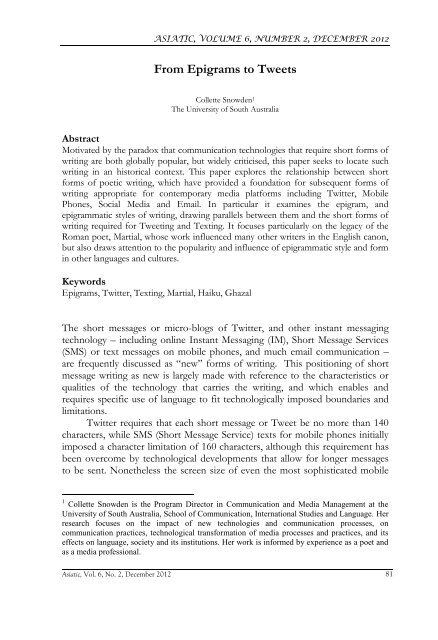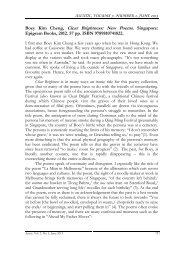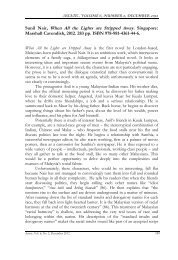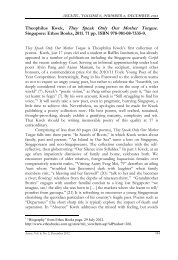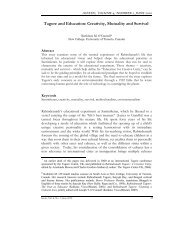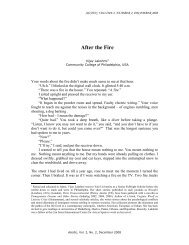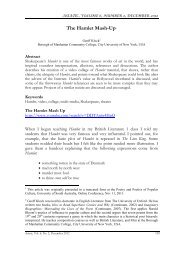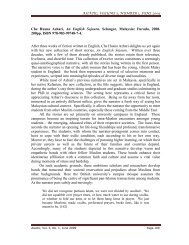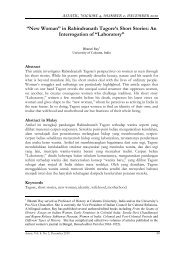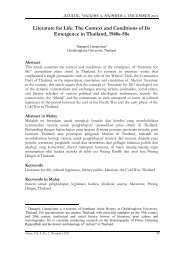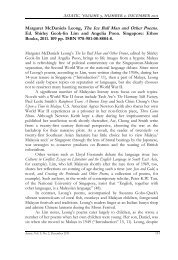From Epigrams to Tweets - Asiatic
From Epigrams to Tweets - Asiatic
From Epigrams to Tweets - Asiatic
You also want an ePaper? Increase the reach of your titles
YUMPU automatically turns print PDFs into web optimized ePapers that Google loves.
ASIATIC, VOLUME 6, NUMBER 2, DECEMBER 2012<br />
<strong>From</strong> <strong>Epigrams</strong> <strong>to</strong> <strong>Tweets</strong><br />
Collette Snowden 1<br />
The University of South Australia<br />
Abstract<br />
Motivated by the paradox that communication technologies that require short forms of<br />
writing are both globally popular, but widely criticised, this paper seeks <strong>to</strong> locate such<br />
writing in an his<strong>to</strong>rical context. This paper explores the relationship between short<br />
forms of poetic writing, which have provided a foundation for subsequent forms of<br />
writing appropriate for contemporary media platforms including Twitter, Mobile<br />
Phones, Social Media and Email. In particular it examines the epigram, and<br />
epigrammatic styles of writing, drawing parallels between them and the short forms of<br />
writing required for Tweeting and Texting. It focuses particularly on the legacy of the<br />
Roman poet, Martial, whose work influenced many other writers in the English canon,<br />
but also draws attention <strong>to</strong> the popularity and influence of epigrammatic style and form<br />
in other languages and cultures.<br />
Keywords<br />
<strong>Epigrams</strong>, Twitter, Texting, Martial, Haiku, Ghazal<br />
The short messages or micro-blogs of Twitter, and other instant messaging<br />
technology – including online Instant Messaging (IM), Short Message Services<br />
(SMS) or text messages on mobile phones, and much email communication –<br />
are frequently discussed as “new” forms of writing. This positioning of short<br />
message writing as new is largely made with reference <strong>to</strong> the characteristics or<br />
qualities of the technology that carries the writing, and which enables and<br />
requires specific use of language <strong>to</strong> fit technologically imposed boundaries and<br />
limitations.<br />
Twitter requires that each short message or Tweet be no more than 140<br />
characters, while SMS (Short Message Service) texts for mobile phones initially<br />
imposed a character limitation of 160 characters, although this requirement has<br />
been overcome by technological developments that allow for longer messages<br />
<strong>to</strong> be sent. Nonetheless the screen size of even the most sophisticated mobile<br />
1 Collette Snowden is the Program Direc<strong>to</strong>r in Communication and Media Management at the<br />
University of South Australia, School of Communication, International Studies and Language. Her<br />
research focuses on the impact of new technologies and communication processes, on<br />
communication practices, technological transformation of media processes and practices, and its<br />
effects on language, society and its institutions. Her work is informed by experience as a poet and<br />
as a media professional.<br />
<strong>Asiatic</strong>, Vol. 6, No. 2, December 2012 81
<strong>From</strong> <strong>Epigrams</strong> <strong>to</strong> <strong>Tweets</strong><br />
phone effectively enforces limitation on the length of text messages, acting as a<br />
technological disciplining or constraint of the author. Similarly, Instant<br />
Messaging (IM) or Chat, the short messaging platforms that are available via<br />
popular applications such as Facebook, Google, Skype, and now available as an<br />
added application for many devices, also favours brevity due <strong>to</strong> the limitations<br />
of the chat window size. While email has no such limitations, the tendency of<br />
email <strong>to</strong> be short and <strong>to</strong> follow the stylistic conventions of the short forms of<br />
writing used in other technological systems has been recorded by contemporary<br />
researchers in an empirical study of message length of email. Gentile et al argue<br />
that,<br />
The impact of text-based SMS and IM has however been such that where<br />
restrictions <strong>to</strong> use are in place, alternatives are sought that obtain the same<br />
benefits. Individuals in such environments often adopt the same<br />
communication patterns in alternative media, e.g., both desk<strong>to</strong>p-based and<br />
mobile email usage often follow the same pattern. (46)<br />
In public critiques of these “new” forms of textual communication some<br />
commenta<strong>to</strong>rs argue that the brief short form writing of the technological<br />
platforms of Twitter, mobile phones and email are responsible for a corruption<br />
of language. For example, in a media report that typifies this position<br />
Shakespearean ac<strong>to</strong>r Ralph Fiennes blamed social networks websites such as<br />
Twitter for “dumbing down” the English language. “We’re in a world of<br />
truncated sentences, soundbites and Twitter,” he said. “[Language] is being<br />
eroded – it’s changing. Our expressiveness and our ease with some words is<br />
being diluted so that the sentence with more than one clause is a problem for<br />
us, and the word of more than two syllables is a problem for us (“Ac<strong>to</strong>r Ralph<br />
Fiennes blames Twitter for dumbing down the English language”).<br />
The opinion that short text messages are evidence that society is in<br />
linguistic decline has been expressed for some time in media reports which<br />
collectively have provided enough sources for a minor field of study<br />
(Carring<strong>to</strong>n; Thurlow). <strong>From</strong> analysis of more than 100 print media accounts<br />
about how new communications technology was adversely affecting literacy,<br />
Thurlow argues that the dominant theme in the reports “was an over-riding<br />
sense of moral panic about declining standards of literacy” (678). However,<br />
recent research, including empirical studies, challenges this view (Drouin and<br />
Davis; Kemp and Bushnell; Wood et al.) and indicates that the use of text<br />
messaging and tweeting has various effects, many of which are positive in<br />
relation <strong>to</strong> literacy.<br />
This paper offers an additional perspective <strong>to</strong> the emerging and<br />
continuing study of the effects of new communication technology platforms on<br />
writing and language. It considers the contemporary short form writing enabled<br />
<strong>Asiatic</strong>, Vol. 6, No. 2, December 2012 82
Collette Snowden<br />
and required by new technology platforms, with reference <strong>to</strong> some influential<br />
epigrammatic forms of writing. It also considers this short form writing in the<br />
context of a broader his<strong>to</strong>ric context in which there is a strong and consistent<br />
his<strong>to</strong>ric drive <strong>to</strong> produce concise writing as a respected and creative literary<br />
achievement.<br />
Rather than condensed – “dumbed down” – versions of narrative or<br />
longer form language, tweets and texts conform in significant respects <strong>to</strong> the<br />
tradition of short form poetry and poetics which has shaped written language,<br />
in English particularly, and in a range of languages and cultures. Furthermore,<br />
short form writing has been especially important in communicating information<br />
quickly and publicly, and in making pithy, witty and astute observations about<br />
people, current events and everyday life.<br />
The short messages of tweets and texts can be considered in the tradition<br />
of the epigram, that is, they can be regarded as a concise written observation<br />
about a person, or current situation, crafted in memorable, figurative language<br />
that plays with and uses the complexity of language. Despite the brevity of the<br />
form and despite the technological constraints of the medium that conveys the<br />
message whatever medium is used, epigrammatic language requires a writer <strong>to</strong><br />
be precise, concise and incisive in order <strong>to</strong> condense an idea or observation in<strong>to</strong><br />
as few words as possible. Technological limitations that require the construction<br />
of concise messages therefore compel writers <strong>to</strong> adopt epigrammatic style. In<br />
this sense the affordances of both the technology and the writing style are not<br />
only compatible, but each requires the other. That is, without technological<br />
limitations the short form writing of tweets and texts would be un-necessary<br />
and conversely if it were not possible, linguistically, <strong>to</strong> communicate effectively<br />
with short form writing of messages and information, the technology would not<br />
be effective.<br />
<strong>Epigrams</strong><br />
Initially, epigrammatic writing was a direct result of the limitations and<br />
constraints of the technology of early writing, which included the expensive,<br />
laborious, even tedious process of carving on s<strong>to</strong>ne. Even early developments<br />
such as writing on clay or parchment were laborious and time intensive.<br />
Progressively technological developments in writing, can be seen generally <strong>to</strong><br />
correspond <strong>to</strong> increased length of written communication, so for example, the<br />
longer forms of novels, are associated with developments in paper production,<br />
ink, typing etc. (Innis; McLuhan; Febvre and Martin; Ong). However,<br />
communication often required short forms of writing in order <strong>to</strong> record and<br />
convey messages and information rapidly. While printing allowed longer form<br />
writing <strong>to</strong> develop, communication technology from the telegraph on has<br />
required and demanded proficiency and skill in short form writing. The epigram<br />
was one of the successful short forms of writing adapted from the earliest<br />
<strong>Asiatic</strong>, Vol. 6, No. 2, December 2012 83
<strong>From</strong> <strong>Epigrams</strong> <strong>to</strong> <strong>Tweets</strong><br />
writing, and it has survived and progressed with successive developments in<br />
writing technologies.<br />
While there is some imprecision about the definition of an epigram, as a<br />
form epigrammatic language is used widely, especially in poetry. Today we find<br />
the epigram embedded in many other forms of writing and used in vastly<br />
different ways. The epigram and other forms of short, concise poetic language<br />
that trace their development <strong>to</strong> the epigram have influenced and can be found<br />
in many literary forms. We are surrounded by epigrams – as headlines,<br />
advertising slogans, mission statements, greeting card messages and so on. Text<br />
messaging and tweeting can therefore be regarded as the latest in a continuum<br />
of short form writing that spans the his<strong>to</strong>ry and evolution of language from its<br />
origins in orality, <strong>to</strong> writing and all of its technologised formats. Users of the<br />
technology are aware of this relationship, as even a cursory exploration of<br />
Twitter and other social media sites will show, for example.<br />
While not every tweet or SMS, or short email, can reasonably be classified as an<br />
epigram, those that actively seek <strong>to</strong> entertain and inform with deliberate<br />
attempts at wit, or humour, or savage commentary, could be classified as<br />
epigrammatic.<br />
The origin of the epigram is generally attributed <strong>to</strong> the Ancient Greeks<br />
who wrote short poems as offerings <strong>to</strong> the Gods, and sometimes <strong>to</strong> show<br />
devotion <strong>to</strong> athletes (Barber, “A Brief for the Epigram”), a use of language,<br />
which reminds us that celebrity worship is not new, and nor is writing about it.<br />
These short poems were especially used on funerary monuments, with the term<br />
epigram derived from the Greek word epigramma meaning “<strong>to</strong> inscribe.” The<br />
nature of the medium used <strong>to</strong> create the earliest epigrams determined the limits<br />
and length of an inscription, with the task of carving a s<strong>to</strong>ne inscription calling<br />
for brevity and linguistic precision.<br />
Scholars in the field of Classical literature have recently begun <strong>to</strong> review<br />
the literary content, value and merits of the earliest epigrams, noting that<br />
<strong>Asiatic</strong>, Vol. 6, No. 2, December 2012 84
Collette Snowden<br />
… a new approach <strong>to</strong>wards archaic and classical Greek epigram is needed.<br />
This new approach will be successful only if it is no longer dominated by<br />
the parameters, assumptions and expectations developed from scholarly<br />
work on Hellenistic epigrams. The fact that archaic and classical Greek<br />
epigrams are inscribed on certain objects does not reduce their readings <strong>to</strong><br />
the informative function – one should at the very least leave room for an<br />
analysis of the various literary techniques and strategies employed <strong>to</strong><br />
accomplish this function. Ultimately, what is needed is an interdisciplinary<br />
approach; all traceable and definable contexts should be taken in<strong>to</strong><br />
account. (Baumbach, Petrovic and Petrovic 6)<br />
Similarly, when we consider contemporary short forms of writing if we leave<br />
room for analysis of “the various literary techniques and strategies employed”<br />
different and more nuanced understandings of their content and meaning are<br />
possible. This is particularly the case for those forms of writing constrained by<br />
the limitations and/or particular affordances of the technological and<br />
communicative contexts that they are constructed <strong>to</strong> fit. Rather than regarding<br />
them as evidence of linguistic decline or as evidence of disrespect for language<br />
use, they can be seen as adaptations <strong>to</strong> a new medium that allows the use of<br />
language, which conforms <strong>to</strong> a long-standing practice that can be regarded as<br />
epigrammatic.<br />
The Properties of Epigrammatic Style<br />
According <strong>to</strong> McKail an epigram must have “the compression and conciseness<br />
of a real inscription, and in proportion <strong>to</strong> the smallness of its bulk must be<br />
highly finished, evenly balanced, simple, lucid” (Select <strong>Epigrams</strong> from the Greek<br />
Anthology). This definition could be applied equally <strong>to</strong> the many other short<br />
forms of writing, including the best, most creative text messages and tweets.<br />
Following the Greek tradition, the literary form of the epigrams was<br />
adopted in the Roman period when it was substantially expanded as a literary<br />
form. Liberation from the constraints of inscription on s<strong>to</strong>ne with the<br />
introduction of manuscripts and papyrus, which with the labour of copyists<br />
made the reproduction of texts possible, also enabled epigrams <strong>to</strong> be more<br />
widely and commercially distributed. Popularised in this way the epigram was<br />
further entrenched as a literary form and device.<br />
<strong>From</strong> the Roman period epigrams have been especially associated with<br />
the work of the Spanish born poet Martial, Marcus Valerius Martialis. Martial<br />
<strong>to</strong>ok as the subjects of his epigrams events and characters of everyday Roman<br />
life (Barber A Brief for the Epigram 20-28) and directed his writing at a wide<br />
audience. Barber argues that Martial was an innova<strong>to</strong>r who “appeared at just the<br />
right moment, blessed with just the right combination of skill and bile and<br />
swagger” (21), and notes that:<br />
<strong>Asiatic</strong>, Vol. 6, No. 2, December 2012 85
<strong>From</strong> <strong>Epigrams</strong> <strong>to</strong> <strong>Tweets</strong><br />
To the extent that we can pin down the essential spirit and character of the<br />
verse epigram as it has come down <strong>to</strong> us – a poem of pointed commentary,<br />
a quick hit of wit, an astringent dose of disabused wisdom, a satirical<br />
needle puncturing sanctimony and hypocrisy, a form of elegant malediction<br />
– it is Martial’s temper and posture we are implicitly calling <strong>to</strong> mind.<br />
(Barber, “A Brief for the Epigram” 21)<br />
Ker, one of Martial’s numerous transla<strong>to</strong>rs, argues that:<br />
Life was his subject, not outworn mythologies or tragic bombast. And<br />
what a medley of detail that life presents! Fops, fortune-hunters and<br />
dinner-<strong>to</strong>uters, dabblers and busybodies, ora<strong>to</strong>rs and lawyers, schoolmasters,<br />
street hawkers, barbers, cobblers, jockeys, architects, auctioneers,<br />
deb<strong>to</strong>rs, bores, quidnuncs, doc<strong>to</strong>rs, plagiarists, hypocritical philosophers,<br />
poisoners, jugglers and acrobats, the slave who has become a knight, or the<br />
knight without a qualification, personal peculiarities, the faults and vices of<br />
fashionable life. He describes a gown or a cup, a picture or a statue, a rich<br />
debauchee's banquet, the courses of a dinner, or the produce of a farm, a<br />
greenhouse, a triumphal arch, a lion in the amphitheatre, a suburban or<br />
country villa, a private bath, a beautiful slave, the noises, duties, and<br />
distractions of the <strong>to</strong>wn, its <strong>to</strong>pography, the parties, theatres, public games,<br />
exercise grounds, the baths and the Saturnalia. (Martial: <strong>Epigrams</strong> in Two<br />
Volumes xiv-xv).<br />
Martial was also known for writing using obscene and insulting language,<br />
because as a popular writer he unders<strong>to</strong>od that this would increase the<br />
readership of his work. More importantly, Martial was an astute self-promoter<br />
and prolific publisher, and unders<strong>to</strong>od, with the canny sense of both an artist<br />
and an entrepreneur, that short form writing was more appealing <strong>to</strong> a general<br />
audience. At the beginning of <strong>Epigrams</strong> Book Two, addressing the book as<br />
presented <strong>to</strong> the reader, he wrote,<br />
To be sure you could bear three hundred epigrams; but who would bear<br />
you, or who would read you all the way through, O book? Learn now the<br />
advantages of a compact booklet. The first is this, that I waste less paper.<br />
Second the copyist will manage it all in just one hour and so will not<br />
devote himself exclusively <strong>to</strong> all my trivialities. The third point is this: if<br />
anyone actually reads you, no matter how bad you may be, you will not be<br />
tiresome. The partygoer will read you when his five measures have been<br />
mixed, but will finish before the cup placed before him begins <strong>to</strong> grow<br />
lukewarm. Do you think you have taken sufficient precautions by means of<br />
your great brevity? Alas, how many people will find you long even so!<br />
(Martial, trans. Williams 22)<br />
<strong>Asiatic</strong>, Vol. 6, No. 2, December 2012 86
Collette Snowden<br />
Imagine then what this fertile mind, with a fondness for gossip, intrigue, scandal<br />
and human foibles and a passionate commitment <strong>to</strong> the literary worth and goal<br />
of brevity would have made of the technology available <strong>to</strong>day. An examination<br />
of Martial’s work indicates that it would be perfectly suited <strong>to</strong> Twitter<br />
Streaming, and there is every indication that he would have relished the<br />
opportunity <strong>to</strong> have an audience of friends of Facebook, loyal followers on<br />
Twitter, and a Blog.<br />
A few examples of Martial’s work indicate that his subject matter and<br />
approach, and in particular his preference for short and pithy writing could be<br />
readily adapted <strong>to</strong> contemporary technology platforms.<br />
A drop of venom, a little bit of gall.<br />
Lacking these, my friend, your epigrams lack all.<br />
(Ctd. in Barber, “A Brief for the Epigram” 20).<br />
The rich know anger helps the cost of living<br />
Hating’s more economical than giving.<br />
(Ctd. in Barber, “A Brief for the Epigram” 25).<br />
In the work of Martial, as Klops<strong>to</strong>ck, a later scholar and admirer explained,<br />
Sometimes the epigram is an arrow: it hits the mark with its point.<br />
Sometimes it is a sword: it hits the mark with its sharp blade.<br />
Sometimes <strong>to</strong>o – the Greeks loved it like this – it is a small painting, a<br />
beam sent out not <strong>to</strong> burn but only <strong>to</strong> enlighten (trans. Williams 7).<br />
Martial’s work was also a major influence on the literature of his own time,<br />
particularly on his friend and contemporary Juvenal, while Juvenal’s satirical<br />
style in turn influenced Martial’s writing. Spanish his<strong>to</strong>rians and critics have<br />
credited Martial, <strong>to</strong>gether with Seneca and Lucian, as one of the founders of the<br />
Spanish literary tradition, but his influence was much wider, particularly on<br />
English language and literature.<br />
When Martial’s work was rediscovered by scholars during the Renaissance<br />
(Sullivan 150-54), the choice of subjects provided a model on which <strong>to</strong><br />
approach writing. His work is acknowledged <strong>to</strong> have influenced literature from<br />
that time. In the English language, Martial’s epigrammatic style influenced a<br />
wide range of writers – with equally influential writers such as Samuel Johnson,<br />
Coleridgehe and Byron (Higashinaka Byron's Indebtedness <strong>to</strong> Martial and Catullus),<br />
amongst them. The influential Ben Jonson, renowned for his wit and intellect,<br />
was so inspired that his “<strong>Epigrams</strong>” was consciously written after the style of<br />
Martial and he, himself, described it as “The ripest of my studies” (ctd. in<br />
Goulding 16). Coleridge’s definition of an epigram, which references<br />
Shakespeare, is perhaps the most repeated definition of an epigram, and a fine<br />
<strong>Asiatic</strong>, Vol. 6, No. 2, December 2012 87
<strong>From</strong> <strong>Epigrams</strong> <strong>to</strong> <strong>Tweets</strong><br />
example. In it, Allan claims, Coleridge “summed up his contemporaries’<br />
continuing fascination with these concise and supremely well-crafted verbal<br />
constructions” (Allan 72).<br />
What is an epigram? A dwarfish whole,<br />
Its body brevity, and wit its soul. (Coleridge, ctd. in Allan 72)<br />
Martial’s significant impact on European literature was both wide and enduring.<br />
Such was the admiration for the epigrammatic writing that he perfected that he<br />
had many English imita<strong>to</strong>rs, beginning with the poet Godfrey of Winchester in<br />
the tenth century (Byrne 61). <strong>From</strong> the early thirteenth century, Italian<br />
humanists rediscovered Martial’s verses and throughout Europe Martial’s<br />
epigrams became a model of style and structure for many poets. Between 1471<br />
and 1993 at least twenty complete editions of his work and numerous<br />
collections of his selected verse were published in many languages.<br />
In the fourteenth, fifteenth and sixteenth centuries, Martial was read and<br />
translated in Italy, France and England. Throughout the Elizabethan, Jacobean<br />
and Res<strong>to</strong>ration periods, Martial’s influence peaked in England, where he had<br />
many transla<strong>to</strong>rs and emula<strong>to</strong>rs amongst writers whose own work has s<strong>to</strong>od the<br />
test of time (Doelman 31-46; Higashinaka 45). Sullivan noted that, “Martial,<br />
through his English admirers and imita<strong>to</strong>rs, affected the development of<br />
English verse until it culminated in the wit and polish of the heroic couplets of<br />
Dryden, Pope and Augustan verse in general” (149). He further argues that<br />
through the popularity and transference of the style and technique of imita<strong>to</strong>rs<br />
and copyists, notably John Owen, Martial’s influence also spread <strong>to</strong> “the<br />
Continent.” Many scholars have also traced the impact of the classic epigram,<br />
and especially the prolific and populist Martial, on poetics in the Western<br />
Tradition <strong>to</strong> the epigrammatic writing of ancient Greece and Rome.<br />
<strong>Epigrams</strong> and Commonplace Books<br />
Furthermore, the influence of epigrammatic style extended well beyond poetry<br />
in<strong>to</strong> other forms of writing in Europe. The widespread use of Commonplace<br />
Books is also evidence of the popularity and effectiveness of short form writing<br />
in English and in other European languages. “Commonplacing” also has its<br />
origins as far back as the Eighth Century BCE (Barber, “A Brief for the<br />
Epigram” 10) but became especially popular in the post-Renaissance period in<br />
Europe (Moss; Havens; Allan 35-46).<br />
Throughout the early modern period commonplace books provided<br />
reposi<strong>to</strong>ries for arranging notes, excerpts, drawings and objects. Regarded as<br />
aids <strong>to</strong> memory and s<strong>to</strong>rehouses of knowledge, they were part of a pedagogic<br />
tradition related <strong>to</strong> rhe<strong>to</strong>ric and the art of memory that dated back <strong>to</strong> the<br />
classical period (Dacome 603).<br />
<strong>Asiatic</strong>, Vol. 6, No. 2, December 2012 88
Collette Snowden<br />
This practice of gathering a variety of material was regarded as so<br />
important that the production of commonplacing was adapted from scholarly<br />
and literary use <strong>to</strong> become an integral part of educational practice. Heath also<br />
notes the connection between the practice of commonplacing and<br />
epigrammatic writing, but goes further <strong>to</strong> make a strong argument for the<br />
academic essay as a legacy of the epigram in the tradition of Martial<br />
(“Rethinking the Sense of the Past: The Essay as Legacy of the Epigram”).<br />
Significantly, the production of Commonplace books borrowed elements<br />
of epigrammatic style, while preserving many of its qualities and characteristics.<br />
The importance of Commonplace Books in the development of writing styles,<br />
conventions and content therefore carried with it critical aspects of<br />
epigrammatic writing. Allan observes that as late as the Georgian period in<br />
England in the compilation of material for commonplace books,<br />
… epigrams in particular remained much the most popular form of extract<br />
at this time. Such preferences are easy <strong>to</strong> explain. For epigrams supplied<br />
what commonplacing itself had always sought – namely compact<br />
distillations of wisdom that were thought-provoking in content and<br />
unmistakably elegant, even downright ingenious, in form (Commonplace<br />
Books and Reading in Georgian England 142)<br />
The relationship between the practice of commonplacing has been<br />
acknowledged as analogous <strong>to</strong> the use and production of various social media<br />
sites by Danzico (12-13), although the analogy between the epigrammatic style<br />
frequently used in commonplacing was not extended <strong>to</strong> tweets and texts.<br />
Therefore, when we examine and analyse the form and content of<br />
contemporary short form writing we can see the residual effect and the legacy<br />
of the tradition of epigrammatic writing. In much the same manner that<br />
innovations in other areas of human activity are said <strong>to</strong> become diffused,<br />
epigrammatic style, form and content, have been constantly diffused and<br />
adapted in<strong>to</strong> written forms of language, but remain as foundations for writing<br />
and writing style, whatever the platform the text is produced for, and on.<br />
The Epigram Beyond Europe<br />
While the importance of Martial and the epigrammatic tradition can be<br />
observed in Europe, the influence of epigrammatic approaches <strong>to</strong> writing are<br />
also present in other cultures where the epigram has related forms. The<br />
Japanese Haiku is perhaps the best known of these, having contributed an<br />
important, influential and popular format for short form writing. Like the 140<br />
character of a Tweet and early SMS messages, the Haiku’s strict short form<br />
demands creativity, imagination and linguistic dexterity. As a literary form it is<br />
amongst the most popular. Today in its adapted English form it remains<br />
popular and influential, especially as it has proved adaptable <strong>to</strong> new media<br />
<strong>Asiatic</strong>, Vol. 6, No. 2, December 2012 89
<strong>From</strong> <strong>Epigrams</strong> <strong>to</strong> <strong>Tweets</strong><br />
platforms through which haiku are sent <strong>to</strong> mobile phones or email, and shared<br />
on social media sites.<br />
And<br />
The Ghazal, a poetic short form popularised from the 6 th century, is one of the<br />
principal forms of poetry in Indo-Perso-Arabic cultures. In its written form the<br />
Ghazal shares many of the characteristics of the epigram, even though it owes<br />
<strong>Asiatic</strong>, Vol. 6, No. 2, December 2012 90
Collette Snowden<br />
little, if anything, <strong>to</strong> the traditions of epigrammatic writing that influenced and<br />
produced short form writing styles in European languages, especially English.<br />
However, much of the work of Rumi, described as the most popular poet in<br />
America (El-Zein 75; Barber, “Rumi Nation” 177), is in the Ghazal tradition,<br />
but also conforms <strong>to</strong> epigrammatic stylistic conventions, especially in<br />
translation. The appeal of the style and its adaptability for new communications<br />
technology platforms is reflected in the numerous applications and services that<br />
deliver Ghazals <strong>to</strong> mobile phones and email via the Internet. For example,<br />
Similarly, while Chinese classical poetry has its own long tradition (Lévy, trans.<br />
Nienhauser), many of its popular and influential forms are short and<br />
epigrammatic in style and approach. For example, Tang poetry, of which the<br />
work of celebrated exponents Du Fu (Tu Fu) and Li Bai (Li Po) had significant<br />
influence beyond China, notably in Vietnam, Korea and Japan, and later<br />
influenced the work of Western writers such as Ezra Pound. As in epigrams, in<br />
Tang poetry there is a similar reliance on repetition, alliteration, the use of<br />
imagery and, above all, brevity.<br />
<strong>Asiatic</strong>, Vol. 6, No. 2, December 2012 91
<strong>From</strong> <strong>Epigrams</strong> <strong>to</strong> <strong>Tweets</strong><br />
The Malay “pantun,” a four-line form of verse, derived from the oral<br />
tradition, also demonstrates the value placed on short form writing. According<br />
<strong>to</strong> Krishnavanie Shunmugam<br />
The pantun is the most outstanding form of poetry in the collection of<br />
Malay oral literature. Winstedt in his introduction <strong>to</strong> Pantun Melayu states<br />
that ‘no one can estimate the mental scope of the Malay without an<br />
understanding of the pantun, the love verse and lampoon of the<br />
Indonesian peoples.’ (25)<br />
In a similar manner <strong>to</strong> Martial’s use of the epigram <strong>to</strong> record and comment on<br />
the rich and varied life of ancient Rome,<br />
The rural Malays of the past created pantuns <strong>to</strong> express an endless range of<br />
emotions. Pantuns were used <strong>to</strong> give advice, <strong>to</strong> poke fun, <strong>to</strong> outwit one<br />
another with verbal excellence, <strong>to</strong> make advances <strong>to</strong> someone, <strong>to</strong> satirize, <strong>to</strong><br />
express sadness, disappointment and so on ( 26).<br />
Epigrammatic approaches <strong>to</strong> writing can be located in many, and perhaps<br />
most, languages, and suggest the universal appeal of writing that is brief, clever<br />
and incisive. The global success of technologies that enable short forms of text<br />
is perhaps more attributable <strong>to</strong> the existing and established practices in human<br />
language that favour epigrammatic expression than <strong>to</strong> the affordances of the<br />
technologies. That being so, the enthusiasm for communications technology<br />
that requires, and encourages, short form writing, and which allows both<br />
authorship and audience <strong>to</strong> proliferate is not surprising, nor is it negative.<br />
The epigram and equivalent epigrammatic forms of writing in all cultures<br />
have been so influential because they are effective, useful and appealing. Unlike<br />
longer s<strong>to</strong>ries, epigrammatic language is quickly recalled and can be relayed with<br />
a high degree of accuracy. Brevity of language has the advantage of being able<br />
<strong>to</strong> travel well and quickly, as there is less detail <strong>to</strong> lose. The short, concise and<br />
clever language of the many styles of writing that conform <strong>to</strong> epigrammatic style<br />
is recognisable in the one liner, the quip, the joke, news headlines, advertising<br />
and more recently in SMS texts, Twitter comments and social media posts.<br />
When we read clever, pithy language in the form of an SMS, Tweet or<br />
email it is the result of technology enabling the use of language for commentary<br />
and communication in a way that is appealing and accessible within specific<br />
technically defined boundaries. However, the language used and the writing<br />
conventions it encourages and requires are informed and influenced by the long<br />
his<strong>to</strong>ry of written language, and its development from even longer oral<br />
traditions. As such, contemporary short form writing used in new technological<br />
platforms, rather than being new, belongs squarely in the tradition of<br />
epigrammatic writing.<br />
<strong>Asiatic</strong>, Vol. 6, No. 2, December 2012 92
Works Cited<br />
Collette Snowden<br />
“Ac<strong>to</strong>r Ralph Fiennes blames Twitter for dumbing down the English language.”<br />
The Daily Mail. 28 Oc<strong>to</strong>ber 2011.<br />
http://www.dailymail.co.uk/tvshowbiz/article-2054689/Ac<strong>to</strong>r-Ralph-<br />
Fiennes-blames-Twitter-dumbing-English-language.html.<br />
Allan, David. Commonplace Books and Reading in Georgian England. Cambridge, UK:<br />
Cambridge UP, 2010.<br />
“Atwitter about Twitter.” Pittsburgh Post-Gazette: (2009): G.5.<br />
Barber, David. “A Brief for the Epigram.” Parnassus: Poetry in Review 24.1 (1999):<br />
8-58.<br />
-------. “Rumi Nation.” Parnassus: Poetry in Review 25. 1 (2001): 176-209.<br />
Baumbach, Manuel, Andrej Petrovic and Ivana Petrovic, eds. Archaic and<br />
Classical Greek Epigram. Cambridge, UK: Cambridge UP, 2010.<br />
Byrne, Shannon N. “Martial and Three Imita<strong>to</strong>rs: Luxorius, Godfrey of<br />
Winchester, and Henry of Huntingdon.” Classical Bulletin 77.1 (2001): 61.<br />
Carring<strong>to</strong>n, Vic<strong>to</strong>ria. “Txting: The End of Civilization (Again)?” Cambridge<br />
Journal of Education 35.2 (2005): 161-75.<br />
Dacome, Lucia. “Noting the Mind: Commonplace Books and the Pursuit of the<br />
Self in Eighteenth-Century Britain.” Journal of the His<strong>to</strong>ry of Ideas 65.4 (2004):<br />
603-25.<br />
Danzico, Liz. “Between the Lines: The Social Life of Marginalia.” Interactions 18.<br />
3 (May-June 2011): 12-13.<br />
Doelman, James. “<strong>Epigrams</strong> and Political Satire in Early Stuart England.”<br />
Hunting<strong>to</strong>n Library Quarterly 69.1 (2006): 31-45.<br />
Drouin, Michelle and Claire Davis. “R u Txting? Is the Use of Text Speak<br />
Hurting Your Literacy?” Journal of Literacy Research 41.1 (2009): 46-67.<br />
El-Zein, Amira. “Spiritual Consumption in the United States: The Rumi<br />
Phenomenon.” Islam and Christian-Muslim Relations 11.1 (2000): 71-85.<br />
Febvre, Lucien and Henri-Jean Martin. The Coming of the Book: The Impact of<br />
Printing 1450-1800. London and New York: Verso, 1976.<br />
Gentile, A. L., et al. "Does Size Matter? When Small is Good Enough."<br />
Proceedings, 1st Workshop on Making Sense of Microposts. Extended Semantic<br />
Web Conference, Heraklion, Crete. (2011): 45-56.<br />
Goulding, Meredith. “A Case for the Epigram: Ben Jonson's ‘Inviting a Friend<br />
<strong>to</strong> Supper.’” Sydney Studies in English 8 (1982): 16-25.<br />
Harris, Sarah. “Open Your Txtbks: Head Timetables Extra English Lessons for<br />
Text-Messaging Pupils.” The Daily Mail. First Edition, (2001): 45.<br />
Havens, Earle. Commonplace Books: A His<strong>to</strong>ry of Manuscripts and Printed Books from<br />
Antiquity <strong>to</strong> the Twentieth Century. New Haven, CT: Beinecke Rare Book and<br />
Manuscript Library, 2001.<br />
<strong>Asiatic</strong>, Vol. 6, No. 2, December 2012 93
<strong>From</strong> <strong>Epigrams</strong> <strong>to</strong> <strong>Tweets</strong><br />
Heath, Shirley Brice. “Rethinking the Sense of the Past: The Essay as Legacy of<br />
the Epigram.” Theory and Practice in the Teaching of Writing: Rethinking the<br />
Discipline. Ed. Lee Odell. Carbondale, IL: Southern Illinois UP. 1993. 105-<br />
31.<br />
Higashinaka, Itsuyo. “Byron’s Indebtedness <strong>to</strong> Martial and Catullus.” The Byron<br />
Journal 39.1 (2011): 45-53.<br />
Innis, Harold. The Bias of Communication. Toron<strong>to</strong>: University of Toron<strong>to</strong> Press,<br />
1951.<br />
Kemp, N and C. Bushnell. “Children’s Text Messaging: Abbreviations, Input<br />
Methods and Links with Literacy.” Journal of Computer Assisted Learning 27.1<br />
(2011): 18-27.<br />
Ker, Walter A.C. Martial: <strong>Epigrams</strong> in Two Volumes. London: William<br />
Heinemann. 1919. E-book. 8 December 2011.<br />
http://www.mindserpent.com/American_His<strong>to</strong>ry/books/Martial/1919_m<br />
artial_epigrams_vol_01.pdf.<br />
Lévy, André. Chinese Literature, Ancient and Classical. Trans. William H.<br />
Nienhauser. Blooming<strong>to</strong>n: Indiana UP, 2000.<br />
MacKail, J. W. Select <strong>Epigrams</strong> from the Greek Anthology. London and New York:<br />
Longmans, Green and Co., 1890. E-book. 30 January 2012.<br />
http://www.hotfreebooks.com/book/Select-<strong>Epigrams</strong>-from-the-Greek-<br />
Anthology-J-W-Mackail.html.<br />
McKean, Erin. “All a-Twitter You’ll Laugh, You’ll Cry, You’ll Wonder Why –<br />
All in 140 Characters.” Bos<strong>to</strong>n Globe. 2009: L.2.<br />
McLuhan, Marshall. The Gutenberg Galaxy: The Making of Typographic Man.<br />
London: Routledge and Kegan Paul, 1962.<br />
Moss, Ann. Printed Commonplace-Books and the Structuring of Renaissance Thought.<br />
New York: Oxford UP, 1996.<br />
Ong, Walter. Orality and Literacy: The Technologising of the Word. London: Methuen,<br />
1982.<br />
“Short and Tweet.” The Economic Times. Bennett, Coleman, 2010.<br />
Shunmugam, Krishnavanie. 2007. “The Translation of Metaphors in Malay<br />
Pantuns in<strong>to</strong> English: In Between Wor(l)ds Transformation and<br />
Translation.” School of Languages and Linguistics Postgraduate Research Papers on<br />
Language and Literature, The University of Melbourne, 6 (2007): 21-40.<br />
Sullivan, J.P. “Martial and English Poetry.” Classical Antiquity 9.1 (1990): 149-74.<br />
Thurlow, Crispin. “<strong>From</strong> Statistical Panic <strong>to</strong> Moral Panic: The Metadiscursive<br />
Construction and Popular Exaggeration of New Media Language in the<br />
Print Media.” Journal of Computer-Mediated Communication 11.3 (April 2006):<br />
667-701.<br />
Williams, Craig A. Martial: <strong>Epigrams</strong>. New York: Oxford UP, 2004.<br />
<strong>Asiatic</strong>, Vol. 6, No. 2, December 2012 94
Collette Snowden<br />
Wood, C. et al. “The Effect of Text Messaging on 9 and 10‐year‐old Children's<br />
Reading, Spelling and Phonological Processing Skills.” Journal of Computer<br />
Assisted Learning 27.1 (2011): 28-36.<br />
Websites<br />
http://www.twitter.com. 3 June 2012.<br />
http://www.sms2friends.com/ghazal-sms. 30 May 2012.<br />
http://tinywords.com/. 30 May 2012.<br />
http://www.freeware4android.net/mo<strong>to</strong>rola-miles<strong>to</strong>ne-device-1050/sms-mmsems-tag/daily-haiku-download-17849.html.<br />
30 May 2012.<br />
<strong>Asiatic</strong>, Vol. 6, No. 2, December 2012 95


